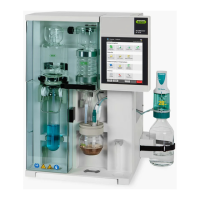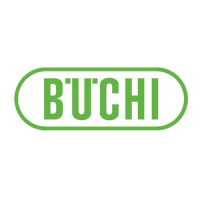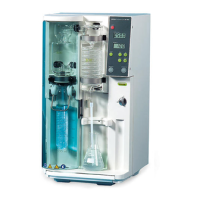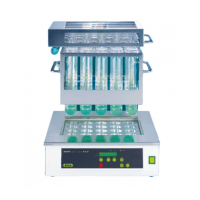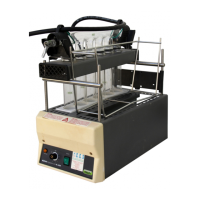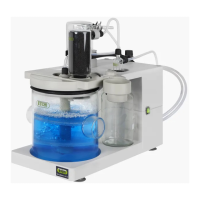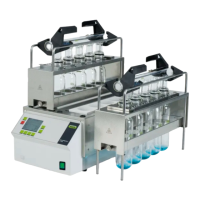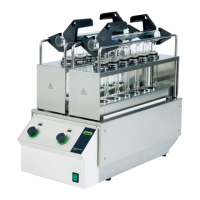Do you have a question about the Buchi KjelFlex K-360 and is the answer not in the manual?
List of acronyms used in the operation manual.
Explains signal words (DANGER, WARNING, CAUTION, NOTICE) and symbols used.
Defines the required qualifications for operating personnel.
Specifies the intended use of the instrument for distillation.
Lists applications that are considered improper or forbidden.
Addresses residual dangers and manufacturer's safety considerations.
Details hazards like explosive atmospheres and corrosives, with precautions.
Describes built-in safety features of the instrument.
Covers operator responsibility, spare parts, and modification rules.
Lists standard instrument configurations and their order numbers.
Details various standard instrument models and their order numbers.
Lists standard accessories included with the instrument and their order numbers.
Lists optional accessories available for the K-360 model.
Provides detailed specifications for the KjelFlex K-360.
Recommendations for titrant concentration and sample amounts.
Lists reference substances and their relevant parameters for analysis.
Details the materials used for different components of the K-360.
Visual identification of main instrument parts with numerical labels.
Explains the basic working mechanism of steam distillation.
Describes the primary application for nitrogen/protein determination.
Lists examples of other steam-volatile substance distillations.
Instructions for setting the stop-cock for different applications.
Details the functions of buttons and controls on the operating panel.
Guidelines for selecting a suitable and safe location for the instrument.
Instructions for safe and correct electrical hook-up of the instrument.
Details on connecting reagent tanks, cooling water, and waste lines.
Specifies requirements for connecting the cooling water supply.
Instructions for connecting the cooling water drain hose.
How to connect hoses for waste and aspiration collection.
Procedure for connecting reagent and waste tanks.
Information on the installation and use of optional level sensors.
Details on connecting printers, keyboards, and titrators.
Instructions for connecting and configuring a printer.
Information on connecting and using an external keyboard.
Setup guidance for boric acid and back titration methods.
Diagram illustrating the instrument's software menu hierarchy.
Explains the function of each control button available in the software.
Steps for preparing the instrument for regular use.
Initial settings that need to be defined before first-time use.
Guide to defining custom distillation methods up to 50.
Daily procedures to prepare the system for operation.
Describes single sample and rack-oriented analysis methods.
Main menu for accessing instrument configuration settings.
Procedure for calibrating the instrument's dosing pumps.
Instructions for setting the instrument's internal clock.
Configuration of language, display, and other general settings.
Configuration options for connecting and using a titrator.
Specific settings for boric acid titration with a titrator.
Setup required for performing back titration using a dispenser.
How to manage user accounts and passwords for instrument access.
Adjusting settings related to the instrument's keypad input.
Process for creating and saving new custom distillation methods.
Explanation of the instrument's Standby and Ready operational modes.
Procedures for preparing the system before analysis.
Steps to preheat the glass parts of the distillation system.
Procedure for priming the system with a clean sample tube.
Instructions for cleaning the instrument at the end of the day.
Procedure for aspirating sample and titration residues.
Step-by-step guide to performing a distillation analysis.
Method for determining single samples without sample list entry.
Method for determining multiple samples entered in a sample list.
Displays the current status and parameters of an ongoing analysis.
Shows the result of a distillation, especially when using a titrator.
Displays a list of previously measured results.
Procedures to follow after the distillation process is complete.
Step-by-step checklists for turning the instrument on and off.
Routine cleaning tasks to ensure proper instrument functioning.
Instructions for cleaning the instrument's external casing.
Procedure to clean glass components to extend their lifetime.
Method for cleaning the rubber seal.
Tasks to perform on a monthly basis, including pump calibration.
Procedure for calibrating the instrument's dosing pumps.
Procedure to verify the correct amount of distillate produced.
Tasks that depend on instrument usage or condition.
Guidelines for cleaning glass and plastic splash protectors.
Instructions for replacing the splash protector component.
Procedure for replacing seals and splash protectors.
Instructions for replacing broken glass components like sample tubes.
Guidance on replacing internal hoses due to wear or chemical exposure.
Recommended maintenance tasks to be performed annually.
Information on contacting Buchi for service, spare parts, and technical advice.
Step-by-step procedure for decalcifying the steam generator.
Table listing common errors, their causes, and corrective measures.
Overview of diagnostic tools for testing components and hardware.
Tests for components like valves, pumps, stirrer, and sensors.
Procedure for testing the functionality of various instrument sensors.
How to test the printer's functionality by printing a test page.
Displays instrument operating hours and reset information.
Shows hardware details such as serial numbers and production date.
Functionality tests typically performed by service technicians.
Steps for safely shutting down and preparing the instrument for moving.
Procedure for draining the steam generator.
Recommendations for packing and transporting the instrument.
Guidelines for environmentally friendly disposal of the instrument.
Catalog of replacement parts for the KjelFlex K-360 with order numbers.
Diagrams illustrating the hosing connections for various configurations.
Compliance statements regarding FCC and Canadian radio interference regulations.
List of acronyms used in the operation manual.
Explains signal words (DANGER, WARNING, CAUTION, NOTICE) and symbols used.
Defines the required qualifications for operating personnel.
Specifies the intended use of the instrument for distillation.
Lists applications that are considered improper or forbidden.
Addresses residual dangers and manufacturer's safety considerations.
Details hazards like explosive atmospheres and corrosives, with precautions.
Describes built-in safety features of the instrument.
Covers operator responsibility, spare parts, and modification rules.
Lists standard instrument configurations and their order numbers.
Details various standard instrument models and their order numbers.
Lists standard accessories included with the instrument and their order numbers.
Lists optional accessories available for the K-360 model.
Provides detailed specifications for the KjelFlex K-360.
Recommendations for titrant concentration and sample amounts.
Lists reference substances and their relevant parameters for analysis.
Details the materials used for different components of the K-360.
Visual identification of main instrument parts with numerical labels.
Explains the basic working mechanism of steam distillation.
Describes the primary application for nitrogen/protein determination.
Lists examples of other steam-volatile substance distillations.
Instructions for setting the stop-cock for different applications.
Details the functions of buttons and controls on the operating panel.
Guidelines for selecting a suitable and safe location for the instrument.
Instructions for safe and correct electrical hook-up of the instrument.
Details on connecting reagent tanks, cooling water, and waste lines.
Specifies requirements for connecting the cooling water supply.
Instructions for connecting the cooling water drain hose.
How to connect hoses for waste and aspiration collection.
Procedure for connecting reagent and waste tanks.
Information on the installation and use of optional level sensors.
Details on connecting printers, keyboards, and titrators.
Instructions for connecting and configuring a printer.
Information on connecting and using an external keyboard.
Setup guidance for boric acid and back titration methods.
Diagram illustrating the instrument's software menu hierarchy.
Explains the function of each control button available in the software.
Steps for preparing the instrument for regular use.
Initial settings that need to be defined before first-time use.
Guide to defining custom distillation methods up to 50.
Daily procedures to prepare the system for operation.
Describes single sample and rack-oriented analysis methods.
Main menu for accessing instrument configuration settings.
Procedure for calibrating the instrument's dosing pumps.
Instructions for setting the instrument's internal clock.
Configuration of language, display, and other general settings.
Configuration options for connecting and using a titrator.
Specific settings for boric acid titration with a titrator.
Setup required for performing back titration using a dispenser.
How to manage user accounts and passwords for instrument access.
Adjusting settings related to the instrument's keypad input.
Process for creating and saving new custom distillation methods.
Explanation of the instrument's Standby and Ready operational modes.
Procedures for preparing the system before analysis.
Steps to preheat the glass parts of the distillation system.
Procedure for priming the system with a clean sample tube.
Instructions for cleaning the instrument at the end of the day.
Procedure for aspirating sample and titration residues.
Step-by-step guide to performing a distillation analysis.
Method for determining single samples without sample list entry.
Method for determining multiple samples entered in a sample list.
Displays the current status and parameters of an ongoing analysis.
Shows the result of a distillation, especially when using a titrator.
Displays a list of previously measured results.
Procedures to follow after the distillation process is complete.
Step-by-step checklists for turning the instrument on and off.
Routine cleaning tasks to ensure proper instrument functioning.
Instructions for cleaning the instrument's external casing.
Procedure to clean glass components to extend their lifetime.
Method for cleaning the rubber seal.
Tasks to perform on a monthly basis, including pump calibration.
Procedure for calibrating the instrument's dosing pumps.
Procedure to verify the correct amount of distillate produced.
Tasks that depend on instrument usage or condition.
Guidelines for cleaning glass and plastic splash protectors.
Instructions for replacing the splash protector component.
Procedure for replacing seals and splash protectors.
Instructions for replacing broken glass components like sample tubes.
Guidance on replacing internal hoses due to wear or chemical exposure.
Recommended maintenance tasks to be performed annually.
Information on contacting Buchi for service, spare parts, and technical advice.
Step-by-step procedure for decalcifying the steam generator.
Table listing common errors, their causes, and corrective measures.
Overview of diagnostic tools for testing components and hardware.
Tests for components like valves, pumps, stirrer, and sensors.
Procedure for testing the functionality of various instrument sensors.
How to test the printer's functionality by printing a test page.
Displays instrument operating hours and reset information.
Shows hardware details such as serial numbers and production date.
Functionality tests typically performed by service technicians.
Steps for safely shutting down and preparing the instrument for moving.
Procedure for draining the steam generator.
Recommendations for packing and transporting the instrument.
Guidelines for environmentally friendly disposal of the instrument.
Catalog of replacement parts for the KjelFlex K-360 with order numbers.
Diagrams illustrating the hosing connections for various configurations.
Compliance statements regarding FCC and Canadian radio interference regulations.
| Brand | Buchi |
|---|---|
| Model | KjelFlex K-360 |
| Category | Laboratory Equipment |
| Language | English |
